Flies
Flies are well adapted for aerial movement, and typically have short and streamlined bodies. The second segment of the thorax, which bears the wings and contains the flight muscles, is greatly enlarged, with the other two segments being reduced to mere collar-like structures. The third segment bears the halteres, which help to balance the insect during flight. A further adaptation for flight is the reduction in number of the neural ganglia, and concentration of nerve tissue in the thorax, a feature that is most extreme in the highly dervied Muscomorpha infraorder.
House Fly
Musca domestica
Appearance

• Adult — 5–8mm in length; thorax grey with 4 narrow stripes; abdomen buff or yellow; 4th wing vein bent and wing tips slightly pointed.
• Larva — White and tapers to a point at the head end. 2 spiracle “spots” at the hind end. Legless. 12 mm long when mature.
Lifecycle
• Eggs laid in batches of 120 to 150 and can hatch in 8 hrs or up to 3 days.
• Larvae take 3 – 60 days to mature; pupae 3 – 28 days.
Habits
• Found in almost all types of premises.
• Breeds in moist decaying vegetable matter.
Lesser House Fly
Fannia canicularis
Appearance
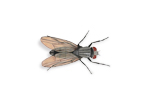
• Adult — 4–6mm in length. Thorax grey with 3 faint black stripes; female abdomen grey and ovoid; male abdomen narrow with pale yellow patches; 4th wing vein not bent.
• Larva — Pale brown, ovoid with whip–like protuberances around the edges.
Lifecycle
• Eggs hatch in 24 hours. Larvae and pupae take 1 – 4 weeks to mature.
• Larvae take 3 – 60 days to mature; pupae 3 – 28 days.
Habits
• Breeds in semi–liquid decaying organic matter.
• Not very attracted to ultra violet light.
• Male has an irregular flight pattern.
Bluebottle
Calliphora vomitoria
Appearance
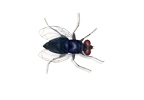
• Adult — 6–12mm in length; metallic blue colour.
• Larva — Similar to the house fly larva in all respects except size. 18 mm when mature.
Lifecycle
• Eggs hatch 0 – 18 hrs (partial development may occur within the female).
• Larvae take 7 – 12 days to mature.
Habits
• Breeds in mostly meat derived substances, sometimes cheese.
• Common pest of dead rodents/birds etc.
Cluster Fly
Pollenia rudis
Appearance
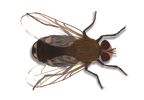
• 6–10mm in length.
• Dark grey–olive thorax clothed with crinkled golden–brown hairs.
• Wings overlap when at rest. Sluggish in flight.
Lifecycle
• Eggs laid in soil.
• Larva develop in earthworms.
Habits
• Often found in large numbers in roof voids in Autumn where they over–winter.
Filter Fly
Family: Psychodidae
Appearance
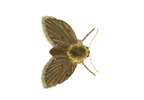
• 2mm in length.
• Tan coloured body appears as grey.
• Wings densely covered in hair and held tent–like over the body when at rest.
Lifecycle
• Eggs hatch 1–6 days.
• Larvae 10–50 days to mature.
• Pupae 1–3 days to mature.
Habits
• Often related to sewage beds where larvae feed on sludge–like organic matter.
Vinegar Fly
Drosophila melanogaster
Appearance
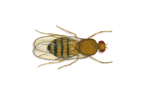
• 3mm in length. Yellow–brown or mottled in colour with bright red eyes.
• Abdomen hangs down in flight, which is slow.
• Tend to hover.
Lifecycle
• Female can lay up to 500 eggs.
• Develops to adult in about 7 days.
• Adult only lives for about 2 weeks.
Habits
• Breeds in fermenting residues found in pubs, fruit & vegetables, breweries, etc.
• Larvae feeds on bacteria and yeast in rotting fruit and veg.
• May also breed in unclean drains and cleaning utensils.
Horse Fly
Cheiracanthium
Appearance
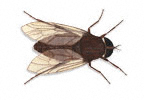
• Adults can be up to 25 mm long.
• Black to dark brown in colour with green or black eyes.
• The males have contiguous eyes, which easily differentiates them from females where the eyes are widely separated.
• A horse–fly’s bite can be very painful. Unlike insects that pierce the skin, horse–flies have mouth parts that work like miniature knives, which they use to slash open the skin with a scissor–like motion.
Lifecycle
• Eggs are laid in masses ranging from 100 to 1000 eggs on a vertical surface overhanging water or wet ground favourable to larvae development. The eggs hatch in 5–7 days.
• They overwinter in the larval stage and pupate during the spring and early summer.
• Adult life cycle is 30 to 60 days.
Habits
• Mating is initiated in the air and completed on the ground where the female then deposits an egg mass sometimes with a shiny or chalky secretion, which aids in water protection.
• The males are mainly pollen and nectar feeders.
• Tabanids are most active during daylight hours.
• As with mosquitoes, it is the female fly that is responsible for biting.
• Relentless attacks on livestock can result in reduced weight gain.
Crane Fly
Tipulidae oleracea
Appearance
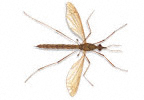
• Adult – 60mm long (wingspan 75mm). They are grey–brown and slender. Their legs are super–thin and long.
• Larvae – 15–75mm. They are worm–like and grey, brown or cream–coloured.
Lifecycle
• Eggs are laid over the water of a pond or lake, or on the vegetation near the lake shore and hatch after about six weeks.
• The larvae live in the water or in moist soil for up to five years depending on the species.
• In the spring the larvae pupate and then emerge as adults.
Habits
• As adults they neither feed, bite nor sting.
• The larvae, called leatherjackets, consume roots (such as garden lawns) and other vegetation.
Lacewings
Chrysoperla carnea
Appearance
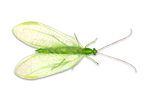
• Approximately 12–20mm long.
• Adults are pale green and have long antennae and bright, golden eyes.
• They have large, transparent, pale green wings and a delicate body.
• Oval shaped eggs are laid at the end of long silken stalks. These single eggs start off green and turn grey after a few days.
• The active larvae are grey or brownish. They are alligator-like with well-developed legs and large pincers with which they suck the body fluids from prey insects such as aphids.
• Adult lacewings feed on pollen and also need nectar or honeydew as food before laying eggs.
Lifecycle
• Oval shaped eggs are laid at the end of long silken stalks. These single eggs start off green and turn grey after a few days.
• The active larvae are grey or brownish. They are alligator–like with well–developed legs and large pincers with which they suck the body fluids from prey insects such as aphids.
• Adult lacewings feed on pollen and also need nectar or honeydew as food before laying eggs.
Habits
• Adults are active fliers, particularly during the evening and at night. Their fluttering flight is particularly characteristic for this species.
• They are considered an important predator of mealybugs in both greenhouses and interior plantscapes. They also feed on (among others) several species of aphids, spider mites (especially red mites), thrips, whiteflies, small caterpillars and beetle larvae.
• They are often used as a biological integrated insect control program.
Autumn Fly
Musca autumnalis
Appearance
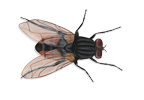
• Females are almost identical to the house fly, but males have an orange abdomen with black mark down the centre.
• The female is approximately 6–7mm, and is generally larger than the male.
Lifecycle
• Breed in animal dung in fields.
• The house fly undergoes a complete metamorphosis with distinct egg, larva or maggot, pupal and adult stages.
• The white eggs, about 1.2 mm in length, are laid singly but pile up in small masses. Each female fly can lay up to 500 eggs in several batches over a three to four day period.
• The life cycle can be complete within 12–20 days depending on temperature, with as many as 12 or several generations occurring in one summer.
Habits
• The flies affect both horses and cattle, and are usually seen on the face often around the eyes.
• At night they rest on vegetation or man-made structures. Most daylight hours are spent feeding on plant sugars, the surface of manure deposits, or on animals.
• On host animals, they obtain protein from nasal mucus, saliva, and tears. The flies have microscopic “teeth” on their mouthparts, which are used to stimulate the flow of tears and aid this feeding process.
• They are strong fliers and are capable of travelling several miles, but most stay within the vicinity of their breeding grounds.
Sand Fly
Spiriverpa lunulata
Appearance
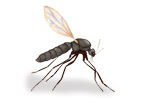
• Adult — 10–11mm. The body has a pale grey colour, eyes are bronze–brown, and legs are dark reddish–brown.
Lifecycle
• Adults are seen from April to September.
• The larvae can take up to two years to develop and live in loose sand.
• In the pupal stage the larvae curls into a circle or “u” shape lasting one or two weeks.
Habits
• Adults live on sandy riverbanks with an open habitat free of shading trees.
• The larvae of stiletto flies are active soil predators.
Whitefly
Cheiracanthium
Appearance
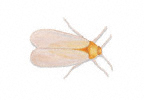
• Adults – 1.5 – 3mm in length. They are white and resemble wedge–shaped moths.
Lifecycle
• The females lay eggs on the leaf surface which hatch 10 days.
• The newly hatched nymphs crawl over the surface of the leaf until they find a suitable place for feeding and settle. They remain there until pupation.
• They can live between 30 and 70 days.
Habits
• Adults are found on the younger leaves and deposit eggs in this level. Pupae and emerging adults are located at the lowest leaf level.
• They cause damage by sucking the sap from the plants.
Yellow Swarming Fly
Thaumatomyia notata
Appearance
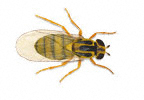
• Small approximately 3mm in length (similar to a fruit fly).
• Adults are bright yellow with black longitudinal stripes on thorax and black transverse stripes on abdomen.
Lifecycle
• Often found hibernating in attics with cluster flies.
• Little is known about these flies, however theie larvae feed upon aphids associated with grass r.
Habits
• Often found in large numbers in roof voids in Autumn where they over–winter.
Tsetse Fly
Genus Glossina - around 34 species
Appearance
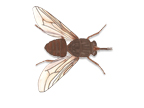
• Similar to other large flies.
• Tsetse have a long proboscis which extends directly forward of the head when not feeding.
Lifecycle
• Can reproduce up to four times a year.
• Adult flies live up to 4 months and are viviparous (bear live young).
• After mating the eggs hatch and remain within the female for 9-10 days before the third instar larvae is deposited in the ground to pupate.
Habits
• Haematophagous – feeds on human or animal blood.
• Associated with the spread of trypanosomes (protozoan parasites), associated with many diseases in animals and man, including Sleeping Sickness (Human African Trypanosomiasis).
• Woodland insects, found in forest edges.
• Numbers of Tsetse flies closely related to number of suitable host animals (large mammals).


